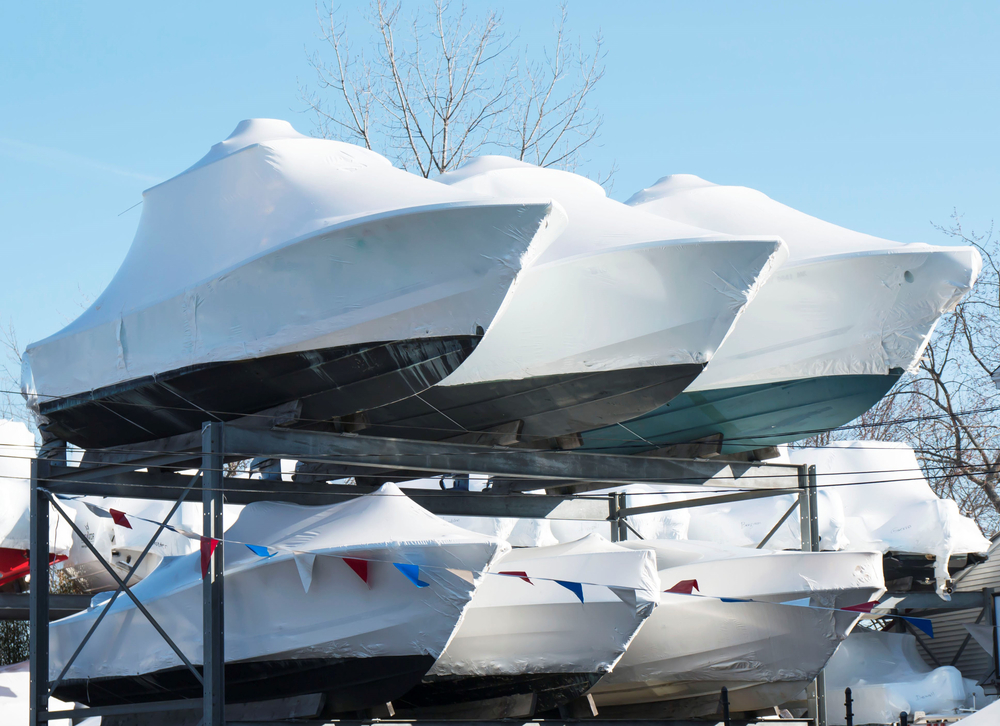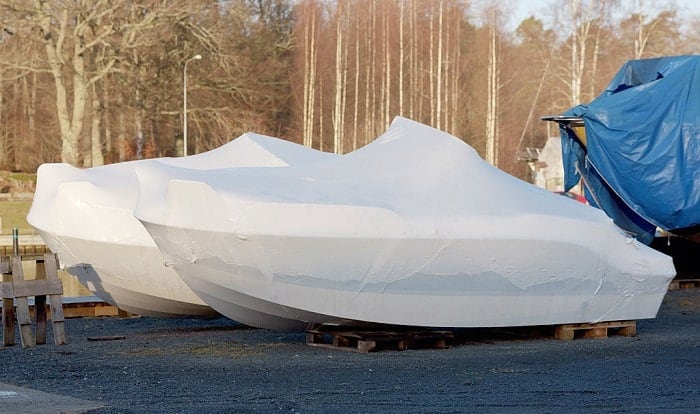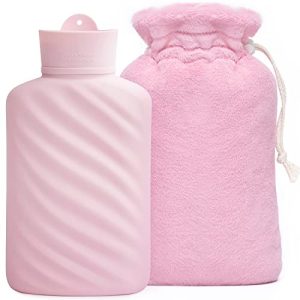Contents
- I. What is Winterizing a Boat?
- II. Factors Affecting the Cost of Winterizing
- III. Average Cost of Winterizing a Boat
- IV. Specific Tasks Involved in Winterizing a Boat
- V. DIY Winterization vs Professional Services
- VI. Finding the Right Winterization Service
- VII. Tips to Reduce Winterization Costs
- VIII. Potential Consequences of Not Winterizing
- IX. Additional Considerations for Winterizing
- X. Conclusion
Are you ready for winter? As the colder months approach, it’s time to start thinking about winterizing your beloved boat. But before you hit the panic button, let’s explore the cost of winterizing a boat. Whether you’re a seasoned boat owner or new to the world of boating, understanding the expenses involved in this essential task will help you budget accordingly. From storage fees to engine maintenance, we’ll break down the costs and guide you through the process, ensuring that your boat is protected and ready to take on the next season. So, sit back, relax, and let’s dive into the cost of winterizing your boat.
I. What is Winterizing a Boat?
A. Definition of winterizing
Winterizing a boat refers to the process of preparing and protecting a boat for the winter season when it will not be in regular use. It involves a series of tasks aimed at safeguarding the boat’s engine, fuel system, water system, electrical system, hull, and deck from the harsh winter conditions. By properly winterizing a boat, you can prevent potential damage and ensure that your boat is in good condition when the boating season resumes.
B. Importance of winterizing
Winterizing a boat is crucial to maintain its longevity and optimal performance. Cold temperatures, freezing water, and ice can cause significant damage to various components of a boat. Without proper winterization, the engine, fuel systems, and water systems can suffer from freezing, leading to cracked hoses, damaged pipes, and costly repairs. Additionally, neglecting to winterize a boat can result in mold and mildew growth, degradation of boat systems, and decreased resale value. Therefore, investing time and effort in winterizing your boat is essential to protect your investment and ensure you can enjoy it for many seasons to come.
II. Factors Affecting the Cost of Winterizing
A. Boat size
One of the primary factors influencing the cost of winterizing a boat is its size. Larger boats typically require more materials, labor, and maintenance compared to smaller boats. The more extensive the boat, the longer it may take to perform the necessary winterization tasks. As a result, larger boats tend to have higher winterization costs compared to smaller vessels.
B. Type of boat engine
The type and complexity of the boat’s engine can also impact the cost of winterizing. Boats with inboard and stern-drive engines often require more thorough preparation, including oil changes, fuel system flushing, and antifreeze application. On the other hand, boats with outboard engines may have a simpler winterization process, as their engines can be tilted out of the water and drained more easily. Therefore, the type of engine your boat has will affect both the time required and the cost of winterizing.
C. Location and climate
The location and climate in which the boat is located can significantly influence the cost of winterizing. Regions with harsh winter conditions, such as extremely low temperatures or heavy snowfall, may require additional measures to protect the boat adequately. For example, boats located in areas prone to freezing temperatures may require more antifreeze application and insulation, which can increase the overall cost of winterization.
D. Additional features and equipment
The presence of additional features and equipment on the boat can also affect the cost of winterizing. Boats with complex systems, such as water heaters, air conditioning, or sophisticated electronics, may require specialized attention and maintenance during the winterization process. Additionally, boats with extensive equipment, such as navigation systems, radios, and fish finders, may need extra care to ensure their longevity. The more features and equipment your boat has, the more time and effort it may take to winterize, which can increase the cost.
E. DIY vs Professional winterization
The decision to either winterize your boat yourself or hire a professional can impact the overall cost. While DIY winterization may seem more cost-effective initially, it is crucial to consider your experience, knowledge, and access to the necessary tools and materials. Improper winterization can lead to costly repairs if mistakes are made. On the other hand, professional winterization services ensure that the boat is winterized correctly, reducing the risk of damage and future expenses. While professional services may come at a higher upfront cost, they can potentially save you money in the long run by preventing costly repairs or replacements.
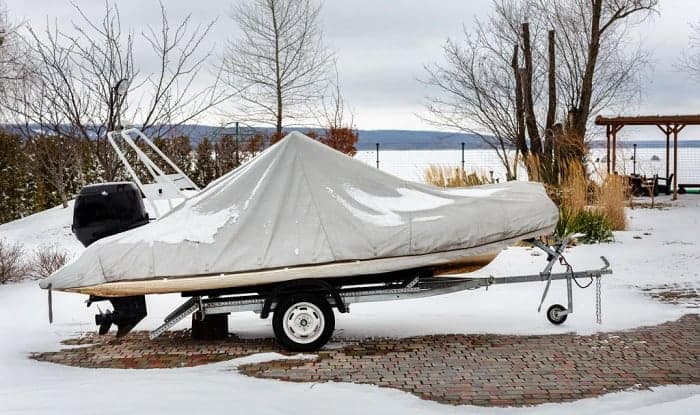
III. Average Cost of Winterizing a Boat
A. Costs for small boats
For small boats, such as canoes, kayaks, or small fishing boats, the cost of winterizing can range from $100 to $300. This includes the basic tasks of engine maintenance, fuel system preparation, water system preparation, and other essential check-ups. However, the actual cost may vary depending on the boat’s specific features, such as the type of engine, enclosed cabin, or additional equipment.
B. Costs for medium-sized boats
Medium-sized boats, including pontoon boats, bowriders, and cuddy cabins, generally have a higher winterization cost compared to smaller vessels. The average cost can range from $300 to $800. These boats may require more extensive maintenance, fuel system treatment, and additional measures to protect against freezing temperatures. The complexity of the boat systems and features can also impact the cost of winterization.
C. Costs for large boats
Large boats, such as yachts or sailboats, often have more complicated systems and require specialized winterization procedures. The cost of winterizing a large boat can range from $800 to several thousand dollars, depending on the boat’s size, features, and engine type. These vessels may require expert attention and specialized equipment, resulting in higher overall costs compared to smaller or medium-sized boats.
D. Additional costs to consider
In addition to the basic winterization costs mentioned above, there may be additional expenses to consider. These can include the cost of winter storage, boat covers, shrink-wrapping, or any necessary repairs or replacements discovered during the winterization process. It’s important to budget for these potential additional costs to ensure your boat is adequately protected throughout the winter season.
IV. Specific Tasks Involved in Winterizing a Boat
A. Engine maintenance
Engine maintenance is a crucial aspect of winterizing a boat. It involves changing the engine oil and filter, inspecting and replacing spark plugs, fogging the cylinders, and adding fuel stabilizer. Proper engine maintenance ensures that the engine is protected from corrosion and remains in good condition during the offseason.
B. Fuel system preparation
Preparing the fuel system involves stabilizing the fuel, emptying the fuel/water separators, and adding fuel stabilizer to prevent fuel degradation. It is important to remove any water from the system to avoid potential freezing and engine damage. Taking these measures helps ensure that the fuel system remains functional and reliable when the boating season resumes.
C. Water system preparation
Water system preparation includes draining the fresh water tanks, water lines, and water heater. Allowing water to remain in the system during winter can lead to frozen pipes, which may result in cracked or damaged plumbing. By completely draining the water system and applying antifreeze, you can protect it from freezing and potential costly repairs.
D. Electrical system preparation
To prepare the electrical system for winter, it is essential to disconnect the batteries and properly store them. Batteries should be charged before storing and kept in a dry, cool place. Additionally, all electrical connections and wiring should be inspected for any signs of wear or damage. Protecting the electrical system during winterization helps prevent battery damage and potential fire hazards.
E. Hull and deck preparation
Cleaning and protecting the hull and deck are critical aspects of winterizing a boat. This involves thoroughly cleaning the boat to remove any dirt, debris, or marine growth. Applying a protective wax or sealant helps prevent fading, discoloration, and damage caused by exposure to the elements. Inspecting and replacing worn or damaged hull fittings, such as through-hull valves or seacocks, is also important during winterization.
F. Interior and exterior cleaning
Cleaning the boat’s interior and exterior is not only for aesthetic purposes but also helps maintain its condition during the offseason. Upholstery should be cleaned and protected, and carpets and flooring should be thoroughly vacuumed and dried. Exterior surfaces, such as windows, metal fittings, and fiberglass, should be cleaned and coated with protective products to prevent deterioration.
G. Storage and cover expenses
Storage and cover expenses are additional costs to consider when winterizing a boat. If you don’t have suitable storage facilities at home, you may need to rent a storage space, which can vary in cost depending on the location and size of the boat. Additionally, investing in a high-quality boat cover, or even professional shrink-wrapping services, can provide extra protection against the elements. While these expenses may increase the overall cost of winterization, they are essential in ensuring your boat’s longevity.
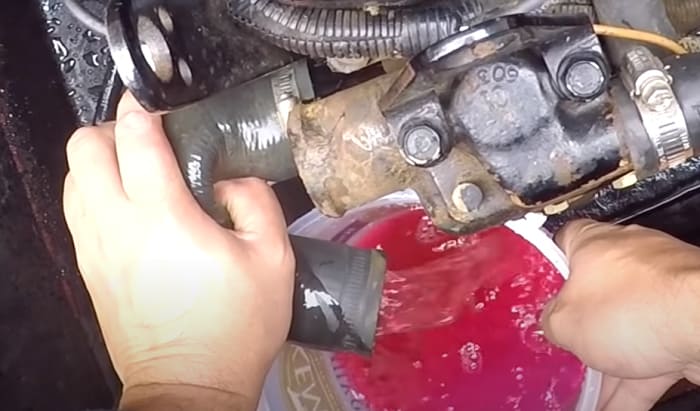
V. DIY Winterization vs Professional Services
A. Pros and cons of DIY winterization
Doing the winterization process yourself can save you some money, as you won’t have to pay for professional services. It also gives you the opportunity to familiarize yourself with your boat’s systems and learn valuable maintenance techniques. However, DIY winterization requires a certain level of knowledge, experience, and access to specialized tools and equipment. If done incorrectly, DIY winterization can lead to costly mistakes and potential damage to your boat. It is crucial to thoroughly research and understand the specific requirements of your boat and its systems before attempting to winterize it yourself.
B. Benefits of professional services
Hiring a professional winterization service offers numerous benefits, especially if you lack the necessary knowledge or experience. Professionals have the expertise to properly perform all the required tasks, ensuring that your boat is adequately protected. They have access to specialized tools, equipment, and materials that may not be readily available to the average boat owner. By opting for professional services, you can have peace of mind knowing that your boat is in the hands of trained professionals who will follow industry best practices.
C. Costs comparison
The cost of professional winterization services varies depending on the size of the boat, location, and additional features. However, it is generally more expensive compared to DIY winterization. While DIY winterization may initially seem like a cost-effective option, it is important to consider the potential risks and expenses associated with mistakes or inadequate preparation. The cost of professional winterization may outweigh the potential costs of repairs or replacements resulting from improper DIY winterization. Ultimately, the choice between DIY and professional services depends on your level of confidence, experience, and the specific needs of your boat.
VI. Finding the Right Winterization Service
A. Research and ask for recommendations
When searching for a reliable winterization service, start by conducting thorough research. Look for reputable companies or professionals with positive reviews and recommendations. Seek advice from fellow boat owners or local boating communities to gather firsthand experiences and referrals. By gathering information from trusted sources, you can narrow down your options and make an informed decision.
B. Evaluate credentials and experience
During your research, evaluate the credentials and experience of the winterization service providers. Ensure that they are certified, licensed, and have a solid track record in boat winterization. Experienced professionals are more likely to have encountered a variety of boats and systems, giving them the expertise needed to handle different winterization requirements.
C. Obtain multiple quotes
To get the best value for your money, obtain multiple quotes from different winterization service providers. The cost can vary significantly, so comparing prices and services offered will help you make a more informed decision. However, remember that the cheapest option may not always be the best, as the quality of service and expertise should also be considered.
D. Check for insurance and warranties
It is essential to verify that the winterization service provider has the necessary insurance coverage. This provides protection in case of any accidental damage that may occur during the winterization process. Additionally, inquire about any warranties offered by the service provider to ensure that you are covered if any issues arise after the winterization is complete.
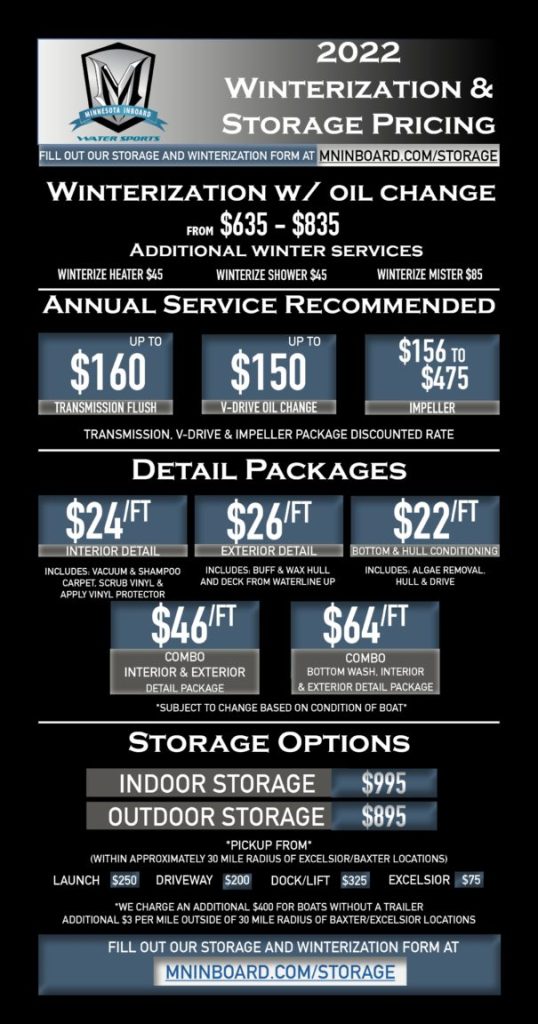
VII. Tips to Reduce Winterization Costs
A. Perform regular maintenance throughout the year
Proper boat maintenance throughout the year can minimize the work and cost of winterization. By regularly inspecting, cleaning, and repairing your boat, you can prevent minor issues from becoming major problems. This includes checking the engine, fuel system, water system, electrical connections, and exterior surfaces. Following manufacturer-recommended maintenance schedules and guidelines can significantly reduce the time and expense required for winterization.
B. Take advantage of offseason and bundle services
Many marinas and boating service providers offer offseason discounts or package deals for winterization services. By taking advantage of these promotions, you can potentially save money. Consider bundling winterization with other services, such as bottom painting or hull waxing, to maximize savings and ensure comprehensive maintenance.
C. DIY certain tasks with proper guidance
If you have some knowledge and experience in boat maintenance, consider taking on certain winterization tasks yourself with proper guidance. This can help save money, especially for simpler tasks such as cleaning, covering, or basic system checks. However, always consult professionals or rely on reliable resources to ensure you are performing the tasks correctly and safely.
D. Properly store the boat during winter
To preserve the condition of your boat during winter, proper storage is crucial. If you have suitable storage facilities at your home, storing the boat yourself can save on rental costs. Ensure the storage area is clean, dry, and protected from extreme temperatures. If you opt for marina storage, inquire about any offseason discounts or long-term storage packages that may be available.
VIII. Potential Consequences of Not Winterizing
A. Engine damage and repairs
Neglecting to winterize a boat can result in significant engine damage. Freezing temperatures can cause water in the engine to expand and crack engine blocks, manifolds, or exhaust systems. Repairs for engine damage can be quite costly, and in severe cases, it may require replacing the entire engine.
B. Degradation of boat systems and components
Without proper winterization, boat systems and components can deteriorate over time. Freezing temperatures, moisture, and lack of maintenance can lead to corrosion, rust, and degradation of important systems such as electrical wiring, plumbing, and fuel lines. This can result in malfunctions, leaks, and potentially hazardous situations.
C. Increased risk of mold and mildew
Moisture, humidity, and lack of ventilation can create an environment conducive to mold and mildew growth inside a boat during winter. Mold and mildew can cause unpleasant odors, staining, and potentially health issues. Cleaning and remediation can be time-consuming and costly, making proper winterization essential to prevent such complications.
D. Decreased resale value
Neglecting to winterize your boat can significantly decrease its resale value. Future buyers will likely be hesitant to purchase a boat with a history of inadequate maintenance or potential damage caused by neglect. By properly winterizing and maintaining your boat, you can preserve its value and make it more appealing to prospective buyers if you decide to sell it in the future.
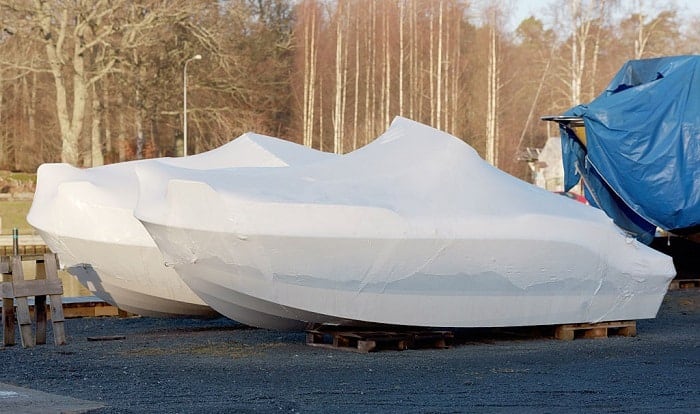
IX. Additional Considerations for Winterizing
A. Insurance requirements
It is crucial to review your insurance policy to ensure you comply with any winterization requirements. Some insurance policies may require specific winterization procedures or proof of professional winterization services. Failing to meet these requirements could potentially void your coverage, leaving your boat unprotected in case of any winter-related damages.
B. Documentation and paperwork
Keep a record of all winterization-related documentation and paperwork. This includes invoices, receipts, checklists, and any reports provided by professional winterization services. These documents serve as proof of proper maintenance and can be valuable for insurance claims or potential resale discussions.
C. Winterizing boat trailers
Boat trailers also require proper winterization to ensure their longevity. This involves inspecting and maintaining the trailer’s tires, bearings, brakes, and lights. Properly cleaning the trailer and applying protective coatings can help prevent rust and corrosion. Additionally, storing the trailer on level ground and using tire supports can prevent tire damage. Neglecting to winterize boat trailers can lead to premature deterioration and potential safety hazards.
D. Preparing for winter boat usage
If you plan to use your boat during winter, it is essential to take additional precautions. Inspect and properly maintain your boat’s systems, equipment, and safety features. Ensure the engine is in good condition, the fuel is treated with antifreeze, and safety equipment such as life jackets and flares are readily accessible. It is crucial to be aware of the specific risks and challenges associated with winter boating and take appropriate measures to ensure your safety.
X. Conclusion
A. Recap of the importance of winterizing
Winterizing your boat is a crucial step to protect your investment and ensure its optimal performance and longevity. By following the necessary winterization tasks, you can safeguard the engine, fuel system, water system, electrical system, hull, and deck from the potential damages caused by freezing temperatures, moisture, and harsh winter conditions. Proper winterization minimizes the risk of costly repairs, degradation of boat systems, mold, and mildew growth, as well as preserving the boat’s resale value.
B. Final thoughts on costs and benefits
The cost of winterizing a boat can vary depending on factors such as boat size, engine type, location, features, and professional services. While DIY winterization may seem more cost-effective initially, it’s essential to consider your expertise and access to necessary tools. Hiring professional winterization services ensures the job is done correctly, reducing the risk of damage and potential future expenses. Ultimately, the choice between DIY and professional winterization depends on your confidence, knowledge, and boat’s specific needs. Regardless of the approach, adequate winterization is essential to protect your boat’s value and ensure enjoyable seasons on the water.
